Mikko Kurimo
LLMs' morphological analyses of complex FST-generated Finnish words
Jul 11, 2024



Abstract:Rule-based language processing systems have been overshadowed by neural systems in terms of utility, but it remains unclear whether neural NLP systems, in practice, learn the grammar rules that humans use. This work aims to shed light on the issue by evaluating state-of-the-art LLMs in a task of morphological analysis of complex Finnish noun forms. We generate the forms using an FST tool, and they are unlikely to have occurred in the training sets of the LLMs, therefore requiring morphological generalisation capacity. We find that GPT-4-turbo has some difficulties in the task while GPT-3.5-turbo struggles and smaller models Llama2-70B and Poro-34B fail nearly completely.
Out-of-distribution generalisation in spoken language understanding
Jul 10, 2024Abstract:Test data is said to be out-of-distribution (OOD) when it unexpectedly differs from the training data, a common challenge in real-world use cases of machine learning. Although OOD generalisation has gained interest in recent years, few works have focused on OOD generalisation in spoken language understanding (SLU) tasks. To facilitate research on this topic, we introduce a modified version of the popular SLU dataset SLURP, featuring data splits for testing OOD generalisation in the SLU task. We call our modified dataset SLURP For OOD generalisation, or SLURPFOOD. Utilising our OOD data splits, we find end-to-end SLU models to have limited capacity for generalisation. Furthermore, by employing model interpretability techniques, we shed light on the factors contributing to the generalisation difficulties of the models. To improve the generalisation, we experiment with two techniques, which improve the results on some, but not all the splits, emphasising the need for new techniques.
On Using Distribution-Based Compositionality Assessment to Evaluate Compositional Generalisation in Machine Translation
Nov 14, 2023Abstract:Compositional generalisation (CG), in NLP and in machine learning more generally, has been assessed mostly using artificial datasets. It is important to develop benchmarks to assess CG also in real-world natural language tasks in order to understand the abilities and limitations of systems deployed in the wild. To this end, our GenBench Collaborative Benchmarking Task submission utilises the distribution-based compositionality assessment (DBCA) framework to split the Europarl translation corpus into a training and a test set in such a way that the test set requires compositional generalisation capacity. Specifically, the training and test sets have divergent distributions of dependency relations, testing NMT systems' capability of translating dependencies that they have not been trained on. This is a fully-automated procedure to create natural language compositionality benchmarks, making it simple and inexpensive to apply it further to other datasets and languages. The code and data for the experiments is available at https://github.com/aalto-speech/dbca.
Advancing Audio Emotion and Intent Recognition with Large Pre-Trained Models and Bayesian Inference
Oct 16, 2023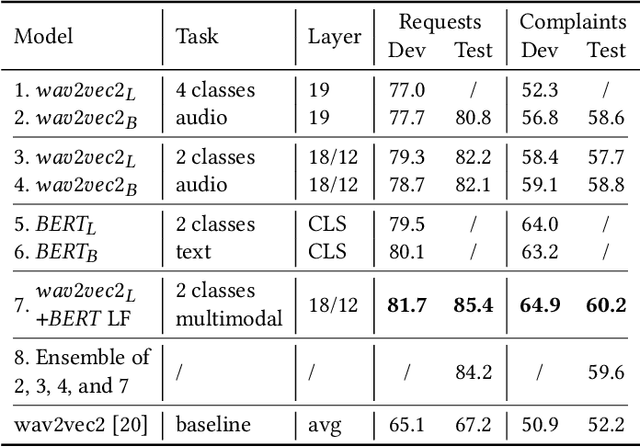

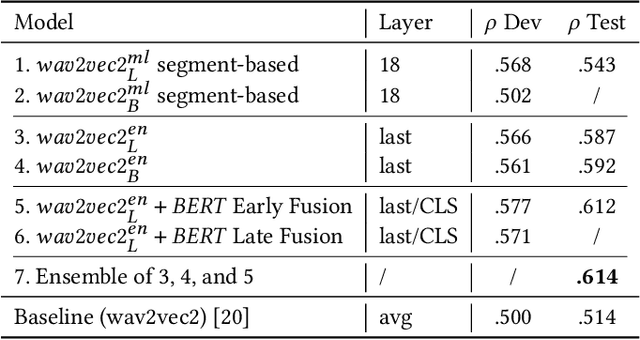
Abstract:Large pre-trained models are essential in paralinguistic systems, demonstrating effectiveness in tasks like emotion recognition and stuttering detection. In this paper, we employ large pre-trained models for the ACM Multimedia Computational Paralinguistics Challenge, addressing the Requests and Emotion Share tasks. We explore audio-only and hybrid solutions leveraging audio and text modalities. Our empirical results consistently show the superiority of the hybrid approaches over the audio-only models. Moreover, we introduce a Bayesian layer as an alternative to the standard linear output layer. The multimodal fusion approach achieves an 85.4% UAR on HC-Requests and 60.2% on HC-Complaints. The ensemble model for the Emotion Share task yields the best rho value of .614. The Bayesian wav2vec2 approach, explored in this study, allows us to easily build ensembles, at the cost of fine-tuning only one model. Moreover, we can have usable confidence values instead of the usual overconfident posterior probabilities.
Topic Identification For Spontaneous Speech: Enriching Audio Features With Embedded Linguistic Information
Jul 21, 2023Abstract:Traditional topic identification solutions from audio rely on an automatic speech recognition system (ASR) to produce transcripts used as input to a text-based model. These approaches work well in high-resource scenarios, where there are sufficient data to train both components of the pipeline. However, in low-resource situations, the ASR system, even if available, produces low-quality transcripts, leading to a bad text-based classifier. Moreover, spontaneous speech containing hesitations can further degrade the performance of the ASR model. In this paper, we investigate alternatives to the standard text-only solutions by comparing audio-only and hybrid techniques of jointly utilising text and audio features. The models evaluated on spontaneous Finnish speech demonstrate that purely audio-based solutions are a viable option when ASR components are not available, while the hybrid multi-modal solutions achieve the best results.
When to Laugh and How Hard? A Multimodal Approach to Detecting Humor and its Intensity
Nov 03, 2022Abstract:Prerecorded laughter accompanying dialog in comedy TV shows encourages the audience to laugh by clearly marking humorous moments in the show. We present an approach for automatically detecting humor in the Friends TV show using multimodal data. Our model is capable of recognizing whether an utterance is humorous or not and assess the intensity of it. We use the prerecorded laughter in the show as annotation as it marks humor and the length of the audience's laughter tells us how funny a given joke is. We evaluate the model on episodes the model has not been exposed to during the training phase. Our results show that the model is capable of correctly detecting whether an utterance is humorous 78% of the time and how long the audience's laughter reaction should last with a mean absolute error of 600 milliseconds.
End-to-end Ensemble-based Feature Selection for Paralinguistics Tasks
Oct 28, 2022Abstract:The events of recent years have highlighted the importance of telemedicine solutions which could potentially allow remote treatment and diagnosis. Relatedly, Computational Paralinguistics, a unique subfield of Speech Processing, aims to extract information about the speaker and form an important part of telemedicine applications. In this work, we focus on two paralinguistic problems: mask detection and breathing state prediction. Solutions developed for these tasks could be invaluable and have the potential to help monitor and limit the spread of a virus like COVID-19. The current state-of-the-art methods proposed for these tasks are ensembles based on deep neural networks like ResNets in conjunction with feature engineering. Although these ensembles can achieve high accuracy, they also have a large footprint and require substantial computational power reducing portability to devices with limited resources. These drawbacks also mean that the previously proposed solutions are infeasible to be used in a telemedicine system due to their size and speed. On the other hand, employing lighter feature-engineered systems can be laborious and add further complexity making them difficult to create a deployable system quickly. This work proposes an ensemble-based automatic feature selection method to enable the development of fast and memory-efficient systems. In particular, we propose an output-gradient-based method to discover essential features using large, well-performing ensembles before training a smaller one. In our experiments, we observed considerable (25-32%) reductions in inference times using neural network ensembles based on output-gradient-based features. Our method offers a simple way to increase the speed of the system and enable real-time usage while maintaining competitive results with larger-footprint ensemble using all spectral features.
Comparison and Analysis of New Curriculum Criteria for End-to-End ASR
Aug 10, 2022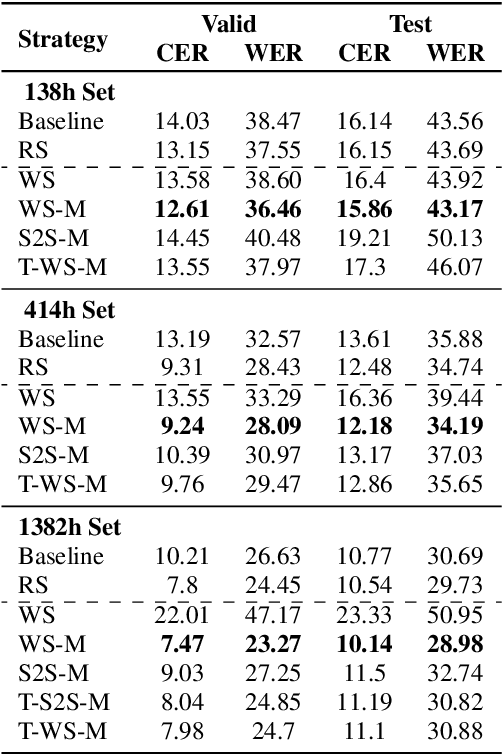
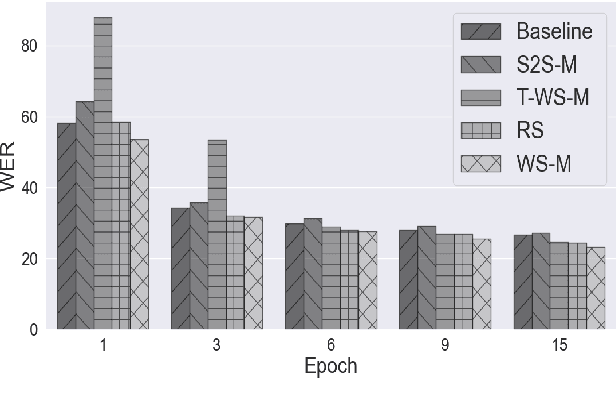
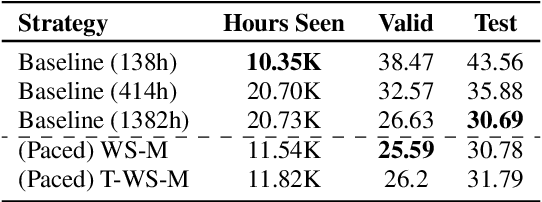
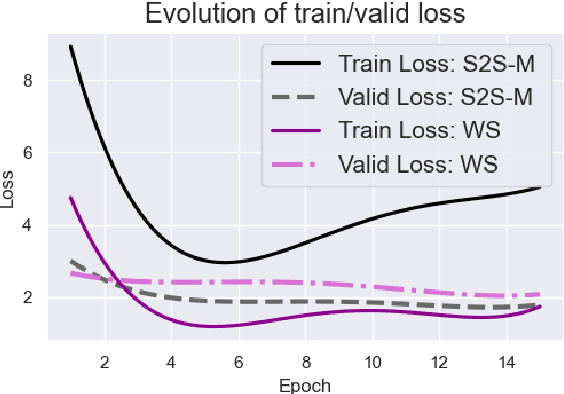
Abstract:It is common knowledge that the quantity and quality of the training data play a significant role in the creation of a good machine learning model. In this paper, we take it one step further and demonstrate that the way the training examples are arranged is also of crucial importance. Curriculum Learning is built on the observation that organized and structured assimilation of knowledge has the ability to enable faster training and better comprehension. When humans learn to speak, they first try to utter basic phones and then gradually move towards more complex structures such as words and sentences. This methodology is known as Curriculum Learning, and we employ it in the context of Automatic Speech Recognition. We hypothesize that end-to-end models can achieve better performance when provided with an organized training set consisting of examples that exhibit an increasing level of difficulty (i.e. a curriculum). To impose structure on the training set and to define the notion of an easy example, we explored multiple scoring functions that either use feedback from an external neural network or incorporate feedback from the model itself. Empirical results show that with different curriculums we can balance the training times and the network's performance.
Finnish Parliament ASR corpus - Analysis, benchmarks and statistics
Mar 28, 2022



Abstract:Public sources like parliament meeting recordings and transcripts provide ever-growing material for the training and evaluation of automatic speech recognition (ASR) systems. In this paper, we publish and analyse the Finnish parliament ASR corpus, the largest publicly available collection of manually transcribed speech data for Finnish with over 3000 hours of speech and 449 speakers for which it provides rich demographic metadata. This corpus builds on earlier initial work, and as a result the corpus has a natural split into two training subsets from two periods of time. Similarly, there are two official, corrected test sets covering different times, setting an ASR task with longitudinal distribution-shift characteristics. An official development set is also provided. We develop a complete Kaldi-based data preparation pipeline, and hidden Markov model (HMM), hybrid deep neural network (HMM-DNN) and attention-based encoder-decoder (AED) ASR recipes. We set benchmarks on the official test sets, as well as multiple other recently used test sets. Both temporal corpus subsets are already large, and we observe that beyond their scale, ASR performance on the official test sets plateaus, whereas other domains benefit from added data. The HMM-DNN and AED approaches are compared in a carefully matched equal data setting, with the HMM-DNN system consistently performing better. Finally, the variation of the ASR accuracy is compared between the speaker categories available in the parliament metadata to detect potential biases based on factors such as gender, age, and education.
Lahjoita puhetta -- a large-scale corpus of spoken Finnish with some benchmarks
Mar 24, 2022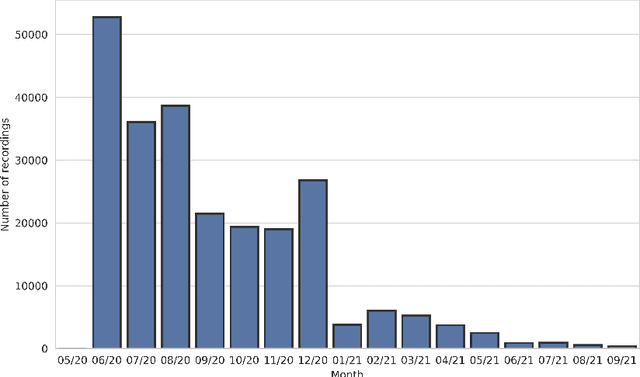
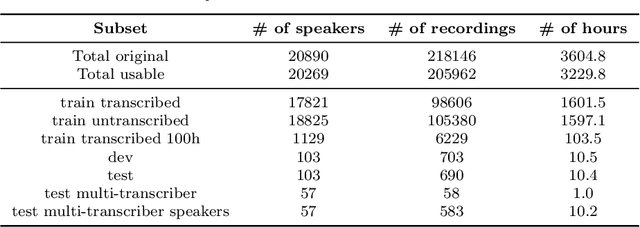
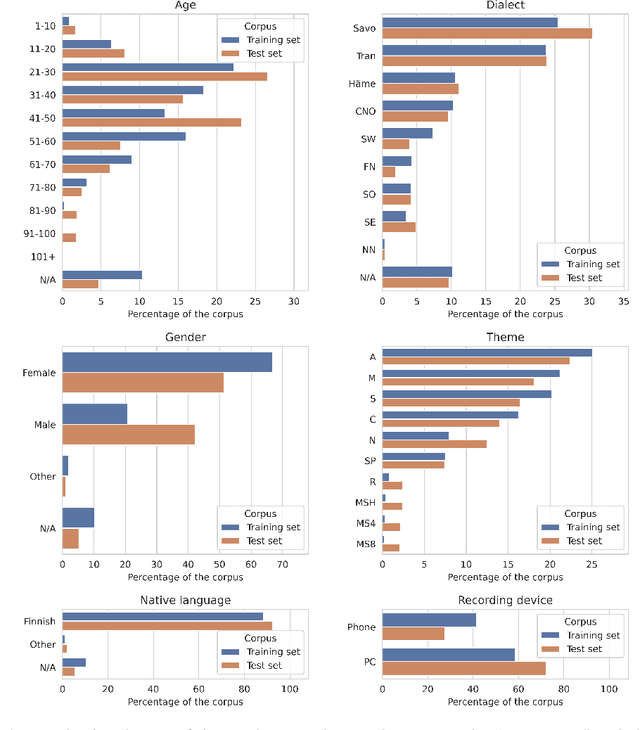

Abstract:The Donate Speech campaign has so far succeeded in gathering approximately 3600 hours of ordinary, colloquial Finnish speech into the Lahjoita puhetta (Donate Speech) corpus. The corpus includes over twenty thousand speakers from all the regions of Finland and from all age brackets. The primary goals of the collection were to create a representative, large-scale resource to study spontaneous spoken Finnish and to accelerate the development of language technology and speech-based services. In this paper, we present the collection process and the collected corpus, and showcase its versatility through multiple use cases. The evaluated use cases include: automatic speech recognition of spontaneous speech, detection of age, gender, dialect and topic and metadata analysis. We provide benchmarks for the use cases, as well down loadable, trained baseline systems with open-source code for reproducibility. One further use case is to verify the metadata and transcripts given in this corpus itself, and to suggest artificial metadata and transcripts for the part of the corpus where it is missing.
 Add to Chrome
Add to Chrome Add to Firefox
Add to Firefox Add to Edge
Add to Edge